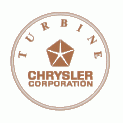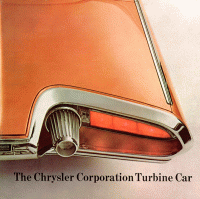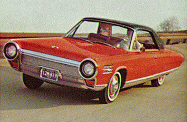 |
 |
 |
 |
 |
 |
 |
 |
 |
 |
 |
 |


In the post World War II years, domestic auto makers used the technological jump-start provided by war production and research to investigate new possibilities for the automotive industry. Research in new technology soared in the late 1940's through the 1960's. U.S. auto makers were busy with new designs for engines, transmissions, suspension and bodies using new materials and techniques for their production.
Chrysler Corporation shared in this revolution by producing technology that has stayed with us ever since. The Hemi, big block wedge, and small block engines all grew from this era. However, there is one design that has largely fallen from the technology spotlight since it was brought to life in 1963.
 Chrysler Corporation's Turbine Car of 1963 was the culmination of years
of research and development in alternative engine design. The idea was to
produce a power plant that would run on many fuels, have fewer moving parts,
while still giving adequate performance and economy for passenger car use.
Chrysler Corporation's Turbine Car of 1963 was the culmination of years
of research and development in alternative engine design. The idea was to
produce a power plant that would run on many fuels, have fewer moving parts,
while still giving adequate performance and economy for passenger car use.
Chrysler engineers had been testing turbine technology in passenger cars since the mid 1950's. The first car to be equipped with a turbine engine was a 1954 Plymouth Belvedere. This "first generation" turbine design produced 100 horsepower and suffered from poor acceleration and fuel economy. As research continued, Chrysler developed a "second generation" turbine that was put to test in 1959. This engine produced 200 horsepower and was built from new materials that proved vastly superior to the previous design. A more refined version of the engine was installed in a 1960 Plymouth, a 2 1/2 ton Dodge truck, and the TurboFlite show car that was designed by Maury Baldwin. A major advancement came in 1962, with the introduction of the CR2A turbine engine. The CR2A made vast improvements in performance and engine braking by incorporating a variable angle fuel nozzle. The CR2A could go from idle to full output in 1.5-2 seconds, as compared with earlier turbines that took 7 seconds to reach full output. After the many advances in turbine engine technology, Chrysler put together plans to produce a limited number of unique cars that would feature the turbine power plant. These cars would not be adaptations of a current production vehicle, but a new design styled and built around the turbine engine.
 Chrysler's acquisition of Elwood Engel from Ford Motor Company in 1961 was
already proving to be a good choice for the company. Plans were
already underway to restyle most of the Chrysler car lines away from the late
1950's styling of Virgil Exner. Engel was the major influence on styling
of the Turbine Car, borrowing heavily from work he did at Ford on the 1961
Thunderbird. The Turbine Car was designed as a personal luxury, four
passenger, two door hardtop. Each car would be finished in Turbine Bronze and
feature full power assists.
Chrysler's acquisition of Elwood Engel from Ford Motor Company in 1961 was
already proving to be a good choice for the company. Plans were
already underway to restyle most of the Chrysler car lines away from the late
1950's styling of Virgil Exner. Engel was the major influence on styling
of the Turbine Car, borrowing heavily from work he did at Ford on the 1961
Thunderbird. The Turbine Car was designed as a personal luxury, four
passenger, two door hardtop. Each car would be finished in Turbine Bronze and
feature full power assists.
 Chrysler decided to produce fifty of the Turbine Cars and release them to
public through a test program. The cars were fabricated by the Italian
coachbuilder Ghia, who had been building Chrysler's limousines and show
cars for a number of years. The cars were shipped back to the U.S., where
they would be distributed to participants of the test program. The
participants were selected from a list of over 30,000 applicants that
Chrysler had collected. Each car would be driven by a program participant
for several months, then passed on. By the end of the test program in
1966, 203 people in 48 states had driven the Turbine Cars.
Chrysler decided to produce fifty of the Turbine Cars and release them to
public through a test program. The cars were fabricated by the Italian
coachbuilder Ghia, who had been building Chrysler's limousines and show
cars for a number of years. The cars were shipped back to the U.S., where
they would be distributed to participants of the test program. The
participants were selected from a list of over 30,000 applicants that
Chrysler had collected. Each car would be driven by a program participant
for several months, then passed on. By the end of the test program in
1966, 203 people in 48 states had driven the Turbine Cars.
Unfortunately, as the test program ended, the results were not as favorable as Chrysler had hoped. Fuel economy was not as good as Chrysler hoped for a production car. People diskliked the acceleration lag of the turbine as compared to conventional piston engines. To the credit of the Turbine Car, people were impressed with the design and features of the car and with its smooth, vibration free ride. Another point in favor of the Turbine, was that the engine required very little maintenance as compared to conventional engines.
The saddest portion of the Turbine Car story is that forty of the cars had to be destroyed to save Chrysler from paying hefty import duties on the Italian built cars. Most of the ten that remain are in the care of private collectors or museums. Two of the Turbine Cars were kept by Chrysler and one is on display in the Chrysler Museum.

tech stuff | photo album | turbine car | imperial place | other places | home page
You can send me mail at:dougc@fourforty.com